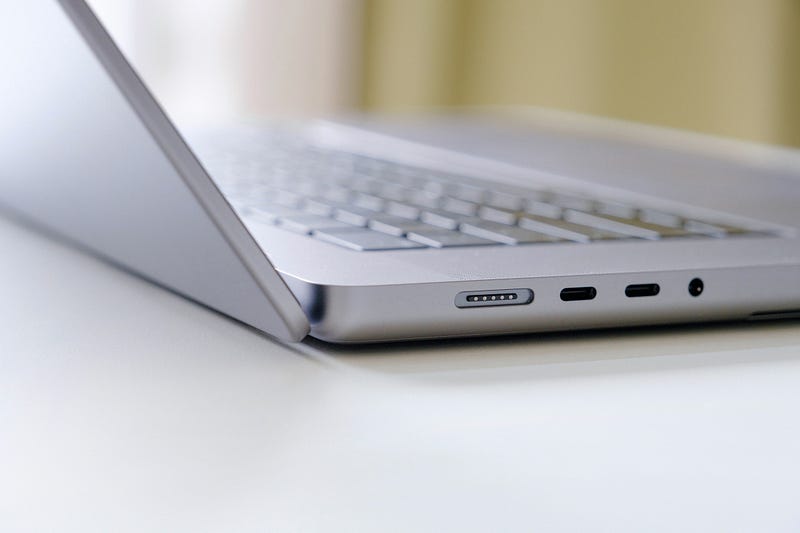One port to rule them all?
This week, Apple unveiled the first iPhone with a USB-C port.
We’ve had Lightning ports on the iPhone since 2012, but time has moved on, and so must the iPhone. RIP Lightning.
For many people, this is a long overdue change. USB-C is already pretty much the standard everywhere else, including on Apple’s laptops. So, what exactly is the benefit of USB-C?
Here are five advantages you need to know about.
1. Design
The design is a key factor in switching to USB-C.
A USB-C cable has pins on the inside of the connector. That means they are much less likely to be damaged. Apple’s Lightning connector, on the other hand, has pins on the outside, so switching to USB-C could lead to more durable cable connectors.
The USB-C port is also smaller than most other ports, so it takes up less space on your device. Gone are the days when laptops had to be chunky to accommodate thicker ports like VGA, HDMI, and even USB-A.
The svelte design of USB-C means thinner and lighter devices.
2. Flexibility
Another benefit of USB-C is its flexibility.
If you have ever struggled to work out which way a USB cable should be plugged in, then USB-C is for you. Just like Lightning, it’s reversible. It works whichever way you plug it in.
USB-C can also replace other ports. The docking station I use at work has four USB-C ports, three USB-A ports, one USB-A port, an Ethernet port, a 3.5mm headphone jack, and an SD card. All of that connects to my Mac with one USB-C cable. That’s because USB-C supports all those data types.
If you have a USB-C device, you can borrow a USB-C charging cable from a friend who also has one. A USB-C cable for Apple devices will work with Android devices, and vice versa.
And, although most people use Bluetooth headphones, wired USB-C headphones are still an option for devices without a traditional 3.5mm headphone jack.

3. Power Delivery
The convenience of replacing a charger with something as universal as USB-C is a great advantage for consumers.
The number of proprietary charging cables on Windows laptops was starting to get ridiculous, and I, for one, won’t miss that.
USB-C cables support up to 240 watts of power. Granted, not all devices need 240 watts, but it opens up the option for fast charging on an even greater number of devices.
I look forward to the day when I am traveling and will only need to bring one type of cable to charge my devices.
4. Data Transfer Speeds
USB-C cables can also be used for data transfer between devices.
USB 2 supported transfers of up to 480 megabits per second. USB 3 increased those speeds to a minimum of 5 gigabits per second. But the latest USB-C connections beat them both quite comfortably.
If you have a USB-C cable that supports Thunderbolt 4, you can look forward to a minimum transfer speed of 40 gigabits per second.
Again, not everyone needs that, but it is useful for transferring 4K video and other large files. Wireless transfer protocols like AirDrop can’t compete with that kind of speed.

5. Availability
A final key benefit of USB-C is that it is already widely available.
This is not a new cable. It has been around since 2014. Like most new standards, it took a while for adoption to spread, but today, the majority of manufacturers have dropped ports in favor of USB-C.
In the United States, there is no such thing as a standard charging cable. You can still buy new Bluetooth speakers that charge via Micro-USB. However, that’s not the case in Europe.
In a bid to reduce electronic waste, the EU mandated that new mobile phones, tablets, digital cameras, headphones, headsets, handheld videogame consoles, portable speakers, e-readers, keyboards, mice, and earbuds should all use USB-C by 2024.
Apple could produce a European version of the iPhone with USB-C and continue to sell an iPhone with a Lightning connector in the United States, but they would lose many of the economies of scale that you get from manufacturing en masse.
Final thoughts
USB-C is not necessarily the perfect solution for all devices.
However, the increasing adoption of USB-C is great news for consumers who can finally consolidate that drawer full of random cables that they keep to charge all their different devices.
Personally, I can’t wait to get a USB-C iPhone. What about you?





This is my first time pay a quick visit at here and i am really happy to read everthing at one place